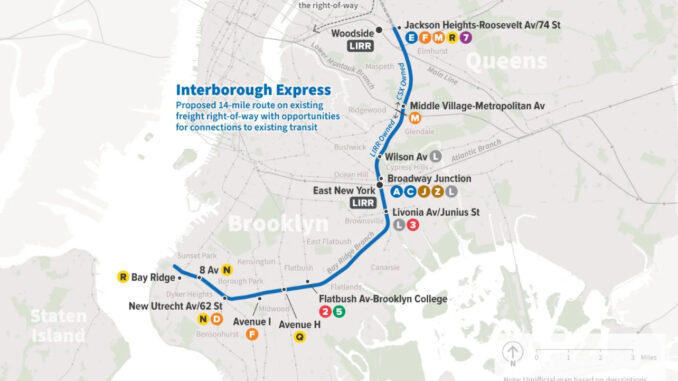
BY KIM GILL
The MTA is partnering with community boards to gain feedback from residents on the proposed Interborough Express Line (IBX). The line, which will run from Jackson Heights, Queens, down to Bay Ridge, Brooklyn, is currently in the planning phase. On Monday, September 16th, members of the MTA’s IBX project team held a pop-up event in East New York, Brooklyn, to discuss the development process, proposed stops, and the potential impact on the community.
Earlier this year, the MTA secured $52 million from Governor Kathy Hochul to greenlight the Interborough Express Line. This light railway will transport commuters from Brooklyn to Queens without entering Manhattan. The proposed route will use an existing 14-mile freight corridor. The IBX will service nearly a million New Yorkers living in both boroughs and anticipates cutting the commute time between Brooklyn and Queens in half. However, some residents are concerned that the MTA isn’t doing enough outreach to keep residents informed on the project’s progress. “They’re not speaking about the component of community work,” stated Community Board 5 Chairwoman Alice Lowman.
The IBX railway will service the most diverse population in the city. According to the project data conducted by the MTA, the line is home to over 900,000 commuters (7 in 10 people of color) and over 260,000 jobs. The MTA anticipates ridership along the IBX will promote community growth and increase the number of residents by 41,000 and jobs by 15,000 by 2045. The route will be a multipurpose line for passenger rail and freight. The line will use two existing rails to complete the route. These lines are the Bay Ridge Branch, which starts in Bay Ridge Brooklyn and ends in Glendale, Queens, and the CSX rail line, which begins in Glendale, Queens, and ends in Astoria, Queens. The section of the CSX from Jackson Heights to Astoria will be used for freight only, while the section from Jackson Heights to Glendale will provide passenger service. Neither of these lines has served passengers since 1924.
The new subway line will add 19 new stations with 17 new connections to other subway lines and the LIRR, as well as 51 new bus line connections. One concern for Fredrick Wells, a Queens resident who regularly travels to Brooklyn, is having enough free transfer stops along the route and using his MetroCard less. He said he hopes that “Instead of me having to tap when you get off, you can transfer and only use one fare as opposed to being forced to use another fare.”
In its Environmental Impact Statement (EIS), the MTA explored all possible routes to construct the line, taking into consideration the community impact as well as the environmental impact. When exploring mode selections between light, conventional, and bus rapid transit, MTA determined that light rail offered the greatest benefits, including capacity, reliability, constructability, vehicle specialization, and cost per rider. According to Charlie Gans, who oversees the construction of the development, “Light rail has a variety of benefits. It achieves good speed. It’s got very strong competitive capacity levels and can make tight turns. It’s just a very flexible mode, and it’s cost-effective.”
For the past year, the MTA has been trying to reach out to communities along the proposed route to get their feedback for the line with both town halls and pop-up events. At the September 16 pop-up, attendees were allowed to go to different stations and ask project teammates questions. They were asked to write suggestions on Post-Its and stick them on the station closest to them on a giant map on the IBX line. However, there was no Q and A session after the presentation, which made some residents uneasy while others felt left out.
According to Albert Scott, an East New York resident and member of the East New York Coalition for Community Advancement, “We’re usually excluded, and here’s where community and local talent could participate. They’re throwing numbers at us about funding when this could have been addressed with a Q and A.” Chairwoman Lowman felt similarly, stating, “We need to have more sessions like this because we need to know the feedback and what they discovered tonight. We need to have a Q and A session; that’s what was missing tonight.” Some of the residents had concerns about how funding was being allocated, whether or not this project would involve eminent domain, remediation, traffic impact, and environmental issues. “My main concern is Wilson Ave. because the right-of-way is too narrow,” states David Kuperberg, Vice President of the Bus Advocacy Passengers United.
Chairwoman Lowman is working with district leaders to organize another event in October with the MTA with a Q and A session for residents with questions and concerns. She hopes the MTA makes more effort to keep the community in the loop as the planning process continues. The MTA did not respond for comment.
